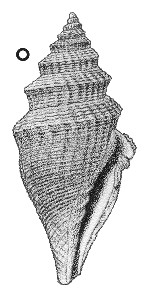
Revised descriptions of New Zealand Cenozoic Mollusca from Beu and Maxwell (1990)

 | Revised descriptions of New Zealand Cenozoic Mollusca from Beu and Maxwell (1990) | 
|
  (Pl. 21o): GS11283, J39/f9500C, Bluecliffs, Otaio River, South Canterbury, Otaian (GNS) |
Beu & Maxwell (1990): Chapter 11; p. 202; pl. 21 o.
Synonymy: Vexillum (Costellaria) rutidolomum Suter 1917, p. 29; Mitra (Cancilla) armorica Suter 1917, p. 27; Proximitra armorica; P. atractoides armorica
Type species of Proximitra Finlay, 1926
Classification: Volutomitridae
Description: Large for genus (height 25-35 mm), elongate-ovate to fusiform, spire 0.4-0.45 total height. Protoconch mamillate, of 1.5 whorls, smooth except for a few very weak axial costellae near end in some shells. Teleoconch of 6-7 whorls of highly variable shape, some shells with weak subangulation at about 0.75 whorl height, and straight or gently convex sides ("armorica" type), others more or less prominently shouldered at 0.5- 0.67 whorl height, the extreme forms with a strongly projecting rim-like keel and concave sides. Last whorl with rounded peribasal subangulation, excavated below with moderately long neck. Axial sculpture highly variable, in some shells — particularly those with only weakly shouldered whorls — consisting of weak costellae on early whorls but becoming obsolete or reduced to growth ridges on later whorls; other shells — typically with prominently shouldered whorls — with relatively prominent costae persisting throughout growth and extending virtually from suture to suture on spire and down to peribasal subangulation on last whorl; in still other shells becoming restricted to rather crude, angular tubercles on shoulder angle on last whorl. Spiral sculpture commencing as 4 or 5 very weak cords, others appearing during growth, so that later whorls are covered with numerous subequal, narrow, low, flat-topped or rounded cords, some with interstitial threads, those on ramp (where present) typically more widely spaced than those below. Aperture narrow, elongate, siphonal canal barely differentiated; columella long, oblique, straight, bearing 4 plaits, 3 of them prominent and subequal, the other (abapical) much weaker and often barely visible in apertural view. Inner lip thinly callused; outer lip thin, weakly flexuous, smooth within.
Comparison: Proximitra rutidoloma is distinguished from other New Zealand Proximitra species mainly by its large size. As noted in the description this is a highly variable species. Most specimens from Bluecliffs and Pareora River (Otaian) have strongly shouldered teleoconch whorls, typically with a rim-like periphery, and have distinct axial sculpture on the adult whorls, and so resemble the type of V. rutidolomum; only a few individuals resemble the type of M. armorica in having a slender shell with only weakly subangled teleoconch whorls and subobsolete axial sculpture. Some shells, however, are intermediate in whorl shape and sculpture, and there can be little doubt that only one, highly variable species is involved. Although M. armorica has page precedence over V. rutidolomum, Beu & Maxwell (1990) selected the latter name to be used for the species named both Vexillum rutidolomum and Mitra armorica by Suter (1917), because it is based on the more common morphotype at Bluecliffs, and because it is the nominated type species of the genus.
Proximitra specimens from Waitakian localities in North Otago and South Canterbury (e.g., Trig Z, Otiake; Brother's Stream, Hakataramea Valley; upper Tengawai River) have the slender fusiform shape of the "armorica" morphotype but are much more weakly sculptured and probably represent a distinct species. Specimens from the two North Otago Altonian localities (Ardgowan; Target Gully), on the other hand, have distinctly shouldered teleoconch whorls and relatively well developed axial sculpture and are referrable to P. rutidoloma, although none has the peripheral keel as strongly projecting as in Otaian shells.
Cernohorsky (1970a, p. 136) classed Proximitra "armorica" as a subspecies of P. atractoides (Tate, 1889) (Balcombian, Victoria), but despite a certain similarity in teleoconch shape and sculpture, P. atractoides differs from New Zealand shells in having a narrowly dome-shaped protoconch of 2.5 smooth whorls, and is not conspecific.
Distribution: Otaian-Altonian; Mount Harris Formation, Bluecliffs, Otaio River, Otaian (type localities of both V. rutidolomum and M. armorica); Mt Horrible, Pareora River; Ardgowan Shellbed; Target Gully Shellbed. Moderately common at all localities.
Cite this publication as: "A.G. Beu and J.I. Raine (2009). Revised
descriptions of New Zealand Cenozoic Mollusca from Beu and Maxwell (1990). GNS
Science miscellaneous series no. 27."
© GNS Science, 2009
ISBN
978-0-478-19705-1
ISSN 1177-2441
(Included with a PDF facsimile file
copy of New Zealand Geological Survey Paleontological Bulletin 58 in CD version
from: Publications Officer, GNS Science, P.O. Box 30368 Lower Hutt, New
Zealand)